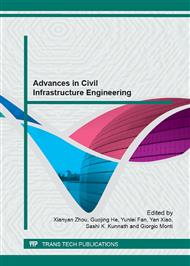[1]
K. Wardhana and F.C. Hadipriono, Analysis of Recent Bridge Failures in the United States. Journal of Performance of Constructed Facilities, Vol.17, No. 3, 2003.
DOI: 10.1061/(asce)0887-3828(2003)17:3(144)
Google Scholar
[2]
New York State Department of Transportation. 1996. Bridge safety assurance, Collision Vulnerability Manual, Albany, New York.
Google Scholar
[3]
American Association of State Highway and Transportation Officials Load and Resistance Factor Design. 2007. AASHTO-LRFD Bridge Design Specifications-fourth edition, AASHTO, Washington, D.C.
DOI: 10.3141/trr.11s.k535736t40586402
Google Scholar
[4]
E.-T. Sherif and E. Severino, Vehicle Collision with Bridge Piers, Journal of Structure Engineering, Vol. (10), 2005, pp: 345-353.
Google Scholar
[5]
Z. Yi, A.K. Agrawal, M. Ettouney, and S. Alampalli, Finite Element Simulation of Blast Loads on Reinforced Concrete Structures using LS-DYNA. 2007 Structures Congress: New Horizons and Better Practices, Long Beach, CA.
DOI: 10.1061/40946(248)3
Google Scholar
[6]
Z. Yi, Blast Load Effects on Highway Bridges, Ph.D Dissertation, City University of New York, New York, 2009.
Google Scholar
[7]
A.K. Zaouk, and D. Marzoughi, Validation of a non-linear finite element vehicle model using multiple impact data. Crashworthiness and Occupant Protection In Transportation Systems, AMD,Vol(218), PP: 91–106, 1996, ASME, New York.
DOI: 10.1115/imece1996-1017
Google Scholar
[8]
Y.D. Hose, Seismic Performance and Flexural Behavior of Plastic Hinge Regions in Flexural Bridge Columns, PhD Dissertation, University of California at San Diego, La Jolla, CA, 2000.
Google Scholar
[9]
T. Krauthammer, and R.K. Otani, Mesh, gravity and load effects on finite element simulations of blast loads reinforced concrete structures, Computers and Structures, 63(6), 1997, p.1113.
DOI: 10.1016/s0045-7949(96)00406-3
Google Scholar
[10]
LS-DYNA; theory manual for version 971.(2007). Livermore Software Technology Corporation.
Google Scholar
[11]
Minnesota Department of Transportation, Bridge Office Substructure Protection Policy. Saint Paul, Minnesota, , 2007.
Google Scholar
[12]
National Transportation Research Center & Heave Vehicle Research Center, 2005. Heavy Vehicle Infrastructure Asset Interaction and Collision. University of Tennessee Knoxville.
Google Scholar
[13]
Texas Transportation Institute, Guidelines for Designing Bridge Piers and Abutments for Vehicle Collisions, College Station, Texas, 2008.
Google Scholar
[14]
D.M. Yvonne and R. Bligh, Evaluation of LS-DYNA Concrete Material Model 159. Texas Transportation Institute, College Station, TX, 2007.
Google Scholar


